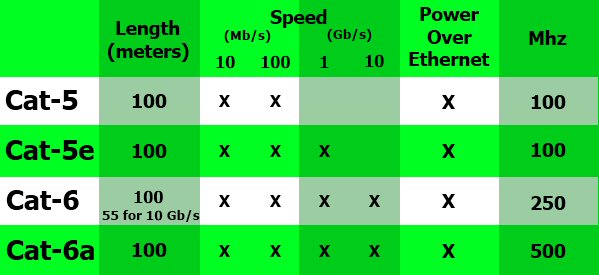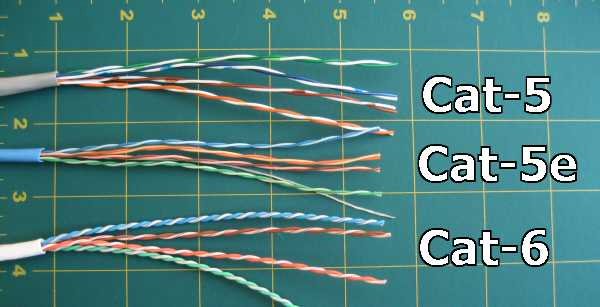
There are different types of Ethernet / network cable available and these are grouped into sequentially numbered categories (CAT) based on different specifications and sometimes the category also has an additional specification of its testing standard (e.g. 5e, 6a). These categories are how we can easily know what type of cable we need for a specific application.
As the category number gets higher, so does the speed and Mhz of the cables as they are tested to ensure they meet the increased standards for speed and crosstalk rejection etc. and is also specified for a given cable length.
Generally speaking for an IP webcam connected to your switch or router you would be able to use a CAT5, CAT5e, CAT6 or CAT6a cable and this will be fine for runs up to 100 metres. But the better the cable is then the more reliable and longer lasting will be the connection and so we recommend always using full specification pure copper network cable and this is especially important when using POE.
Now if you want to use POE then you will be well advised to use a CATx cable that is high copper content. There is increasing use of cable sold as Cat5e which is not made of pure copper. This is Copper Clad Aluminium or CCA. This cable uses aluminium wire which is a cheaper metal and it is just plated over with copper. This tends to work well for many applications and is of course much cheaper than pure copper cable, but if you want to run POE down it you really need a good copper conductor. If you install your network cable to your camera with a good quality high copper content cable then you should have no trouble powering the camera up to 100 metres from the POE switch, POE router or POE injector, but if you use a lower grade cable then you will very likely suffer from voltage drop due to the increased resistance of the cable to the current supplied from the POE device. you can tell the difference between copper and copper clad aluminium cable easily just by picking up a drum of copper and a drum of aluminium at the same time - guess which one weighs more? Yes copper is heavier and more expensive, but if you want good resiults with your POE camera then make sure you dont scrimp on the cable.
Networks installed with copper covered aluminium cable will never fully comply with the Cat5e standards due to the different electrical properties of aluminium over copper. These cables often have markings like Cat5e ANSI/TIA-568-C, ISO/IEC 11801 or BS EN 50173 fooling the buyer into thinking they are fully compliant.
So to put it into easy to understand terms, Copper Clad Aluminium (CCA) over pure copper Cat5 is:
40% Higher resistance which is very bad for POE, it has poor flexibility and can break much more easily, it oxidises easier causing poor terminations in the patch panels, plugs and sockets and is much more likely to break as it is not as good at being flexible as pure copper is.
So once again we strongly advise using full spec. pure copper cables to ensure your IP Webcam and POE connections are up to standard and will perform reliably.
General Information on Network Cable.
Now thats been said (and hopefully taken on board) here is just some more general information on performance and construction of the different CATx cables available which you may find of interest.
Physical differences between the categories of the network cable eliminate interference and allow for faster speeds using wire twisting and isolation. The twisting of cable was invented by Alexander Graham Bell in 1881. This was for use on telephone wires that were run along side power lines. He discovered that by twisting the cable between every 3-4 utility poles, it reduced the interference and increased the range.
The two main physical differences between Cat-5 and Cat-6 cables are, the number of twists per cm in the wire, and the thickness of the covering sheath. All this determines the final performance of the cable and for full specification cable this is listed in the below table.

Cable twisting length is not standardized, but typically there are 1.5-2 twists per cm in Cat-5(e) and 2+ twists per cm in Cat-6. Within a single cable, each colored pair will also have different twist lengths based on prime numbers so that no two twists ever align. The amount of twists per pair is usually unique for each cable manufacturer. As you can see in the above picture, no two pairs have the same amount of twists per inch.
Many Cat-6 cables also include a nylon spline which helps eliminate crosstalk. Although the spline is not required in Cat-5 cable, some manufactures include it anyway. In Cat-6 cable, the spline is not required either as long as the cable tests according to the standard. In the picture above, the Cat-5e cable is the only one with a spline.
While the nylon spline helps reduce crosstalk in the wire, the thicker sheath protects against near end crosstalk (NEXT) and alien crosstalk (AXT) which both occur more often as the frequency (Mhz) increases. In this picture the Cat-5e cable has the thinnest sheath, but it also was the only one with the nylon spline.
Different Category Cable Twists

Different Category Cable Sheaths

So if you want reliable operation of your POE IP Webcam you can use CAT5, CAT5e, CAT6 or CAT6a providing they are the full copper grade cables and CCA cable is not recommended!
